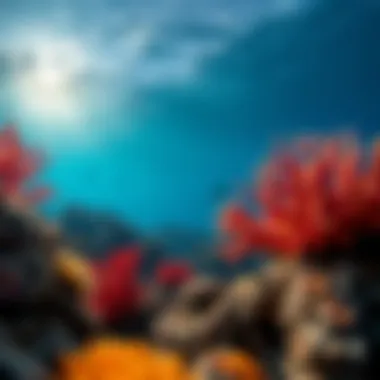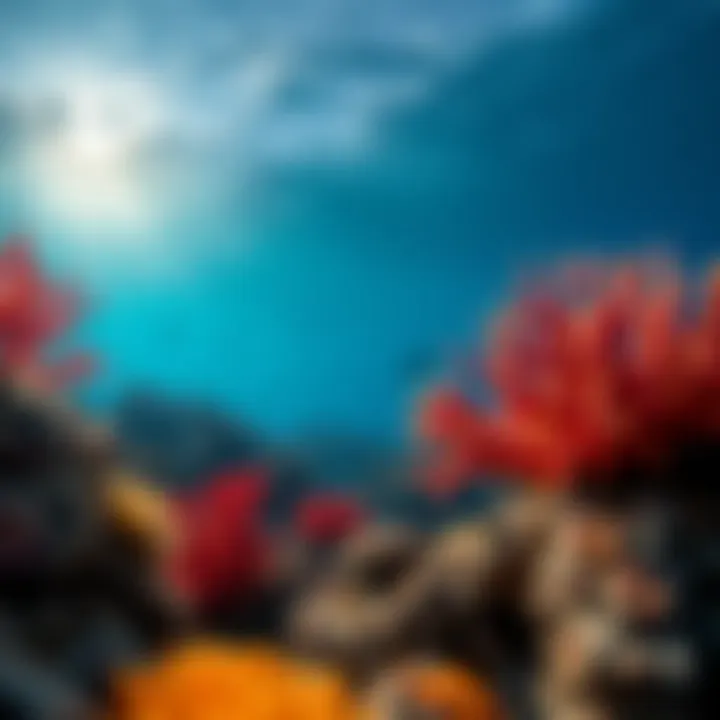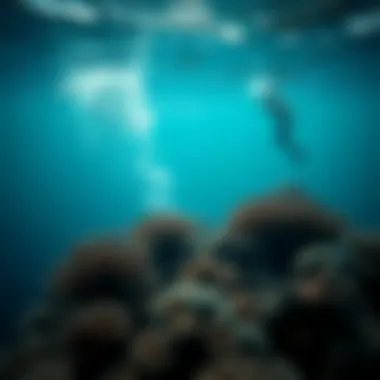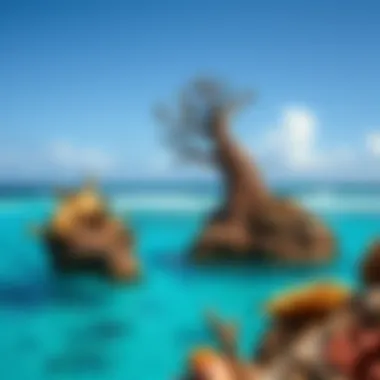Exploring the Great Barrier Reef: A Comprehensive Study


Intro
The Great Barrier Reef is not just a strip of stunning blue waters—it’s a flourishing mosaic of life, a giant aquatic tapestry teeming with vibrant marine beings, and a significant geological wonder off the northeastern coast of Australia. Beyond its mesmerizing colors and picturesque vistas, the reef serves as a critical habitat for countless species, some of which exist nowhere else on the planet.
As we embark on this exploratory journey, our goal is to unfold the layers that compose this natural marvel. From the geological processes that gave rise to its stunning features to the urgent threats it faces today, we will traverse through the complexities of the reef's ecosystem. Not only do we delve into the scientific aspects, but we will also shine a light on the cultural significance the reef holds for indigenous communities who have long relied on its bounty for sustenance and spiritual guidance.
Understanding the Great Barrier Reef is far from a simple task. It requires rigorous examination and multi-faceted discussions around conservation challenges, ecological significance, and continuous research efforts aimed at preserving its fragile beauty. This article intends to serve as a compass for surfers, travelers, outdoor enthusiasts, sports coaches, and fitness professionals who seek knowledge, inspiration, and maybe a little adventure in these interconnected waters.
By weaving together diverse strands of information, we aim to reveal why the Great Barrier Reef remains a vital emblem of our planet’s natural heritage. Tune in as we dissect the intricate interrelations within this underwater city, highlighting both its wonders and the pressing threats that could change its narrative forever.
Prelims to the Great Barrier Reef
The Great Barrier Reef is not just a collection of coral and marine life; it is an intricate tapestry of ecological significance and cultural heritage that offers a window into the health of our planet. Stretching over 2,300 kilometers along the Queensland coast, this natural marvel is acknowledged as one of the most biodiverse regions on Earth. Midst its turquoise waters, one finds vibrant coral gardens, sprawling seagrass meadows, and a multitude of marine creatures that denote a delicate yet vital ecosystem.
Understanding the Great Barrier Reef is pivotal, especially given the pressures it faces today from climate change, pollution, and overexploitation. By diving into its geographical layout and historical context, one begins to appreciate not just its beauty but also the intrinsic value it holds for environmental stewardship and cultural identity.
In this article, we will explore its geographical nuances and historical significance, highlighting how they relate to the broader narrative of conservation and sustainability, thus setting the stage for deeper discussions on its biological and ecological traits.
Geographical Overview
Geographically, the Great Barrier Reef encompasses a vast area off the northeastern coast of Australia. It is not merely a homogeneous mass of water and coral; it is a complex maze of islands, cays, and underwater formations. The reef is situated within the Coral Sea and consists of over 2,900 individual reefs, forming a natural barrier that has a variety of ecosystems within its bounds. This expanse can be likened to a massive underwater city where each reef acts as its unique neighborhood, bustling with marine life.
The climate here is warm and tropical, with water temperatures gently oscillating between 23°C and 29°C. This temperature range is crucial for the survival of coral reefs. The ocean currents that flow through the region also play a significant role in nutrient distribution, which is essential for sustaining diverse marine populations.
Moreover, the reef’s proximity to the mainland fosters rich interactions between terrestrial and marine ecosystems. The estuaries flanked by coastal mangroves function as sanctuaries for various juvenile marine species. When the rains come, nutrient-rich runoff from the land infuses the coastal waters, promoting abundant life.
Historical Significance
Historically, the Great Barrier Reef has been a site of cultural and economic importance for thousands of years. Indigenous Australians, such as the Torres Strait Islanders and coastal Aboriginal communities, have long regarded the reef as a sacred space, rich in resources and spiritual significance. Their connection to the reef is more than just practical—it is woven into their cultural narratives, art, and traditions. They possess an intricate understanding of its tides and seasonal cycles, mirroring a profound respect for the ecosystem around them.
European exploration began in the 17th century, with Captain James Cook's journey in 1770 leading to greater awareness and subsequent exploitation. Despite its allure, the reef's environmental health has been continually compromised due to invasive practices borne out of colonization and unchecked tourism expansion.
Today, acknowledging the reef's cultural significance alongside its ecological value becomes vital as we navigate conservation efforts. It is essential to foster partnerships between indigenous peoples and scientific communities to ensure that future endeavors to protect the reef honor its historical roots while promoting sustainable use of its resources.
Formation and Geology
Understanding the formation and geology of the Great Barrier Reef is crucial for grasping its ecological dynamics and environmental resilience. These aspects shape not only the physical landscape but also influence the myriad forms of life that the reef supports. The reef itself stands as a testament to the intricate processes of nature, layered with the history of geological shifts and biological evolution. By highlighting the foundational elements of this world heritage site, we can appreciate its value and the delicate balancing act required to preserve it.
Origin of Coral Reefs
Coral reefs, especially the Great Barrier Reef, are often misconstrued as mere underwater gardens. In reality, they are complex ecosystems that began their journey over 20 million years ago. The genesis of these reefs revolves around tiny coral polyps, which are the building blocks. These minuscule creatures build their hard structures from calcium carbonate, and as generations of polyps died, their skeletons accumulated to form vast frameworks of coral.
- Habitat Formation: Coral polyps thrive in warm, shallow waters, where sunlight can penetrate, facilitating the photosynthesis process of symbiotic algae known as zooxanthellae. These algae provide energy to the corals in exchange for a protective home, creating a symbiotic relationship that is vital for the reef's sustainability.
- Geological Influences: The Great Barrier Reef's formation also intertwines with geological factors such as sea level changes, tectonic activity, and sediment dynamics. For example, during glacial periods, lower sea levels exposed the reef, while during warmer interglacial periods, rising waters allowed coral growth to flourish outwards and upwards.
The continual interplay of these natural forces has sculpted the reef into its present form, making it an ever-evolving entity that reflects both past events and current environmental factors.
Types of Coral Present
The Great Barrier Reef hosts a stunning diversity of coral species, each playing unique roles within this delicate ecosystem. Understanding these types not only enlightens us on the biodiversity present but also stresses the importance of safeguarding these species for future generations.
- Hard Corals: Often referred to as stony corals, these are the primary architects of the reef. They contribute to the physical structure and strength of the reef, with species such as Porites and Acropora being prominent representatives. Their ability to thrive in various environments makes them essential to the reef's longevity.
- Soft Corals: Unlike hard corals, soft corals like gorgonians and sea fans do not produce a hard skeleton. They provide critical habitat and act as food sources for various marine creatures.
- Vulnerable Species: As delightful as they are diverse, certain coral species are endangered or at risk due to environmental stressors. The Acropora genus, known for forming the complex structures that support marine life, faces threats from rising water temperatures and acidification.
Together, the various coral types construct an intricate network that serves as a habitat for an array of marine life, highlighting the importance of each species in maintaining the ecological balance of the reef.
"The Great Barrier Reef is a living example of our planet's biodiversity, intricately connected through geology and ecology."
As the Great Barrier Reef faces increasing threats from climate change and human activity, an understanding of its formation and geology becomes indispensable. This knowledge arms conservationists, researchers, and the public with the insights needed to advocate for effective conservation measures. By fostering a deeper appreciation for the reef's origins and components, it's easier to realize the urgency of preserving such an extraordinary natural wonder.
Biodiversity of the Reef
The Great Barrier Reef is a veritable treasure chest of biodiversity, boasting over 1,500 species of fish and coral alone. This staggering variety is not merely a sight for sore eyes; it plays a critical role in the health and functionality of the entire ecosystem. The intricate relationships between species contribute to nutrient cycling, habitat provision, and overall ecosystem stability. Understanding this biodiversity is paramount, as it sheds light on the delicate balance of life within the reef and highlights the urgent need for conservation efforts.


Marine Species Diversity
In the world of marine species, the Great Barrier Reef is akin to a bustling city, alive with vibrant activities. The reef is home to hundreds of species of corals, acting as the bone structure of this underwater metropolis. Among them, the Hard Coral species like Acropora and Montipora stand out, creating complex habitats that provide shelter and breeding grounds for myriad fish species.
Moreover, it’s not just about fish and coral; the reef's richness extends to invertebrates such as sea turtles, jellyfish, and mollusks that collectively enhance the ecological structure of the area.
- Fish Species: Includes Clownfish, Parrotfish, and Grouper.
- Coral Species: Features Staghorn Coral and Brain Coral.
- Invertebrates: Comprises Starfish, Echinoderms, and various types of Crustaceans.
"The marine diversity of the reef reflects a complex web of life, each strand returning the favor by supporting others within their ecosystem."
Recognizing the importance of such diversity goes beyond appreciation; it calls for awareness. The manner in which these species interact contributes to the adaptability and resilience of the reef. This biodiversity contributes not only to the ecological opportunities but also enhances recreational experiences, drawing both tourists and researchers eager to engage with this aquatic wonder.
Endangered Species of the Reef
Despite its natural beauty and rich biodiversity, the Great Barrier Reef faces an alarming reality—many species are now classified as endangered. Factors like climate change, pollution, and overfishing have put immense pressure on the fragile inhabitants of this ecosystem. Species such as the Dugong and Green Sea Turtles are among those at risk, symbolizing the threats posed to the entire marine environment.
- Dugong: Often called the "sea cow," this gentle grazer relies on seagrass meadows, which are diminishing at an alarming rate due to human activities.
- Hawksbill Turtle: Known for its beautiful shell, this turtle is critically endangered, with habitat destruction significantly contributing to its decline.
- Coral Species: Certain types of coral, including Staghorn and Elkhorn Coral, have suffered severe population declines due to bleaching and disease brought on by rising ocean temperatures.
The implications are dire. The loss of these endangered species would not only disrupt the ecosystem but would also reduce the resilience of the entire reef to climate challenges. If we are to explore and savor the beauty of the Great Barrier Reef, we must also commit to safeguarding it for future generations, fostering sustainable practices that protect its intricate tapestry of life.
For more on the efforts to protect these remarkable species, visit:
In sum, the biodiversity of the Great Barrier Reef is a story of survival and interconnection. It proves just how crucial each creature is within this underwater universe and emphasizes a need for concerted action towards preservation and respectful tourism. This understanding paves the way for conversations and actions that honor the beauty and complexity of the reef.
Ecological Importance
The Great Barrier Reef represents an astonishing ecosystem that reaches beyond mere biodiversity. Its ecological significance cannot be overstated, as it serves as a vital component of marine life, influencing a multitude of processes and relationships in the ocean. The reef acts like a bustling metropolis for marine species and supports various life forms, from the tiniest microorganisms to majestic marine mammals.
Role in Marine Ecosystems
The reef's role in marine ecosystems is nothing short of foundational. It provides habitat, food, and breeding grounds for a staggering array of aquatic life. Coral reefs globally, including the Great Barrier Reef, are often termed the "rainforests of the sea" due to their immense biodiversity. Research shows that they account for approximately 25% of all marine species. This rich diversity stems from the complex structure of coral formations, which create an intricate habitat for fish, crustaceans, mollusks, and many others. Notably, species such as the clownfish rely specifically on anemones found within the reef to thrive.
Moreover, corals play a critical role in nutrient cycling. By contributing to the availability of essential nutrients in the water, they help sustain other marine organisms, linked closely like a web in the larger ocean ecosystem. When corals engage in photosynthesis, they produce energy that can be shared with their symbiotic algae, which in turn nourish the corals. This mutualistic relationship highlights how the reef supports not only a variety of species but promotes ecosystem health overall.
Impact on Coastal Protection
Aside from its role in supporting marine biodiversity, the Great Barrier Reef has immense importance in protecting coastal areas. Its natural structure acts as a buffer against wave action, storm surges, and erosion. In fact, studies show that coral reefs can reduce wave energy by up to 97%, serving as a shield for coastal communities, beaches, and infrastructures. This function is particularly crucial given the increasing instances of tropical storms and rising sea levels attributed to climate change.
Protecting the reef means protecting entire coastlines from destructive forces. Areas that benefit from the reef's protective qualities often have lower incidences of flooding, thereby safeguarding homes and ecosystems along the shore. Such interactions exemplify how a healthy reef system contributes not only to the natural environment but also to human well-being and economic stability.
The ecological significance of coral reefs emphasizes the need for conservation efforts, highlighting the delicate balance between marine life and coastal protection.
The health of the Great Barrier Reef is vital not just for marine life, but also for human life. The interconnectedness of these ecological elements underscores the importance of maintaining this natural wonder for future generations.
Cultural Relevance
The Great Barrier Reef is not just renowned for its breathtaking beauty and ecological importance; it also carries deep cultural significance, particularly for the Indigenous peoples of Australia. Their relationship with the reef extends far beyond mere appreciation of its physical attributes. It is woven into their identity, traditions, and spiritual beliefs. To ignore this cultural context would be akin to overlooking the very essence of what the reef represents.
Indigenous Connections
Indigenous communities, such as the Goorie and Torres Strait Islander peoples, have lived in harmony with the Great Barrier Reef for thousands of years. This connection is not only historical but also deeply spiritual. They view the reef as part of their ancestral lands, integral to their history and culture. Many traditions are centered around the natural cycles of the reef, reflecting a profound understanding of its ecosystems.
The stories passed down through generations often revolve around the sea and its diverse life forms. These narratives nurture respect for nature and emphasize sustainable practices. The reef is often referred to in songs, dances, and art, highlighting a deep-rooted acknowledgment of its value. For these communities, the reef is not merely an ecosystem; it is a living entity deserving of reverence and care.
"The sea is a memory, the waves speak the stories of our ancestors."
— Indigenous Elder
Art and Literature
The cultural relevance of the Great Barrier Reef doesn't stop with oral traditions. It has also significantly influenced art and literature. For many artists, the stunning colors, forms, and life within the reef have become a source of inspiration. This can be seen in the works of various Indigenous and contemporary artists who bring the reef to life through their canvases, sculptures, and installations.
In addition to visual art, the reef has continually featured in various literary works. It is depicted as a vibrant living landscape, often serving as a backdrop to stories that highlight the relationship between nature and humanity. Poetry and prose about the reef evoke emotions tied to loss, love, and connection, reflecting broader themes of environmental conservation and the responsibility humans hold to protect natural wonders.


For instance, books exploring marine life or cultural identities often cite the Great Barrier Reef as a central theme, allowing readers to delve into its significance. These interpretations foster a greater awareness of the reef's fragility in the face of modern threats and underscore the urgent need for conservation efforts that honor both Indigenous rights and ecological sustainability.
By understanding the cultural relevance of the Great Barrier Reef, we not only enrich our knowledge of this incredible ecosystem but also honor the traditions and stories that have been shaped by it over centuries. It reminds us that conservation efforts must include a respect for the Indigenous connections to land and sea, enriching our collective mission to protect this iconic marine treasure.
Tourism and Economic Impact
Tourism holds a significant place in the narrative of the Great Barrier Reef, acting as a double-edged sword. It not only brings much-needed revenue to the region but also creates a heavy reliance on the health of this delicate ecosystem. The allure of bright corals and vibrant marine life draws millions of visitors each year, making it a cornerstone of the economic structure for surrounding communities. With the scuba diving and snorkeling industries booming, local businesses thrive while embracing the role of environmental stewards. Yet, this influx also raises pressing questions about sustainability and conservation.
Visitor Statistics
The sheer volume of visitors to the Great Barrier Reef speaks volumes about its global appeal. Over two million people visit each year, eager to explore the underwater wonderland. This popular destination sees tourists from every corner of the globe. For instance, in 2019, the tourism sector generated approximately $6.4 billion for Australia’s economy, reflecting the reef's role as a vital economic engine. Most visitors engage in snorkeling, diving, and boat tours—activities that allow them to interact with the rich biodiversity firsthand.
However, it’s worth noting that the COVID-19 pandemic led to a significant drop in visitor numbers. The lack of tourists reminded us all how intertwined the local economy is with reef health.
The trends in tourism show not only the number of visitors but also their demographic diversity. Young adventurers, families seeking educational experiences, and environmental enthusiasts all contribute to a varying demand for different types of tours. While many arrive with eco-conscious intentions, educating travelers about their impact is crucial.
Sustainable Tourism Practices
As the awareness around environmental conservation grows, sustainable tourism practices are becoming top of mind for operators and visitors alike. Green certifications are being pursued by tour companies, and more are adopting practices that minimize their ecological footprint. Some key strategies include:
- Education and Awareness: Tour operators now emphasize the importance of not disturbing marine life, minimizing waste, and following strict guidelines to protect the ecosystem.
- Eco-Friendly Tours: Many companies are shifting towards eco-friendly vessels and equipment, reducing emissions and harmful substances entering the water.
- Community Involvement: Collaborating with local communities fosters a connection between visitors and indigenous cultures, ensuring that tourism supports those who have long relied on the reef for their way of life.
By implementing these sustainable practices, stakeholders aim to create a win-win situation. Tourists partake in unforgettable experiences while leaving a minimal mark on the natural world they came to enjoy. As the saying goes, "Take only pictures, leave only bubbles."
Over the long term, marrying tourism with conservation efforts can ensure that future generations will also have the chance to marvel at the wonders of the Great Barrier Reef.
All said and done, tourism around the reef serves as a testament to the balancing act required in today's world: harnessing economic benefits while safeguarding a precious natural heritage. For further information, you can explore resources such as Wikipedia, Britannica, and governmental sites like Australia.gov.au.
The future of this unique ecosystem depends not just on visitation numbers but on a united effort to preserve its beauty and integrity. Understanding this relationship is crucial in the quest for responsible tourism.
Major Threats to the Reef
The Great Barrier Reef is not just a stunning natural wonder; it's a complex ecosystem that plays a crucial role in marine biodiversity and global climate regulation. However, this jewel of the ocean faces a myriad of threats that put its survival at risk. Understanding these threats is essential for the ongoing conversation about conservation and sustainable practices that could protect this vital natural resource for generations to come. By examining the significant challenges, we are better equipped to advocate for its preservation and to appreciate the fragility of such an incredible environment.
Climate Change Effects
It’s no secret that climate change is a formidable opponent for environments across the globe, and the Great Barrier Reef is no exception. One of the most alarming effects is coral bleaching, a process where corals lose their vibrant colors and become vulnerable to disease. When water temperatures rise just a couple of degrees above average for extended periods, stressed corals expel the symbiotic algae that live within their tissues. This not only strips the corals of their color, but it also deprives them of a crucial source of nourishment, leading to widespread mortality.
Additionally, the rising temperatures can lead to more extreme weather events, increasing the frequency and intensity of storms that can physically damage the reef. These storms stir up sediment that smothers coral and disrupts the delicate balance of the ecosystem. The sudden shifts in climate can also affect fish populations and other marine life that depend on the reef for habitat and food.
"In the battle against climate change, the reef stands as a testament to resilience, but every increase in temperature inches it closer to devastation."
As surfers or travelers who enjoy these beautiful waters, it becomes vital to lobby for policies aimed at carbon reduction and to support advancements in renewable energy.
Pollution and Overfishing
Pollution is another major player in the threats to the Great Barrier Reef. Agricultural runoff, which can include fertilizers and pesticides, flows into the oceans, changing the water quality. Excessive nutrients from this runoff can cause algal blooms. These blooms block sunlight, preventing coral from photosynthesizing effectively and ultimately leading to the decline of coral health.
Plastic pollution is also taking a toll on the reef's ecosystem. Marine life often mistake plastic for food, resulting in injury or death. Every piece of garbage that ends up in the water is a nail in the coffin for biodiversity. It can hamper creatures that rely on the healthiest reef possible, such as turtles and fish, which can have knock-on effects throughout the larger marine ecosystem.
Moreover, overfishing exacerbates these problems by disrupting the balance of predator and prey. Removing too many fish from the environment can lead to a chain reaction, affecting everything from coral growth to the overall health of the reef. Sustainable fishing practices is the way forward, but these methods have to be widely promoted and practiced to be effective.
Conservation Efforts
The Great Barrier Reef is an astonishing natural habitat that requires ongoing conservation efforts. This effort is vital not only for preserving its rich biodiversity but also for maintaining the ecological balance that the reef offers to marine life and coastal communities. The significance of conservation is underscored by the increasing threats the reef faces from various human activities and climate change. Effective conservation strategies help to mitigate these threats while ensuring future generations can enjoy and study this majestic ecosystem.
Investments in research and sustainable practices are essential to safeguarding this world heritage site. Support from local communities and international partners plays a crucial role in the ongoing initiatives.
Local Initiatives
Various local initiatives have sprung up aimed at protecting the reef and its surrounding environments. Community-led programs often incorporate educational campaigns that aim to heighten awareness about the reef’s ecological significance. For instance, many coastal towns participate in reef clean-up days, engaging residents and tourists alike in active restoration efforts. These community efforts not only address pollution but also foster a sense of stewardship among participants.


Some local councils partner with conservation groups to monitor reef health and implement successful practices in sustainable tourism.
- Coral nurseries: Some regions have established coral nurseries to propagate coral fragments, which can then be transplanted onto degraded reef areas.
- Fishing regulations: Local fishermen are encouraged to adhere to sustainable fishing practices by observing seasonal closures and size limits. This helps to maintain fish populations that are essential for reef health.
Additionally, local indigenous communities play a pivotal role in these efforts, using traditional ecological knowledge to inform modern conservation strategies. Incorporating indigenous practices not only respects cultural heritage but also enhances the effectiveness of conservation techniques.
Global Support and Policies
On a broader scale, global support and policies are indispensable in managing and protecting the Great Barrier Reef. Various international agreements, such as the Paris Accord, set guidelines that nations must adhere to in combatting climate change, which poses a significant threat to the reef.
Key global organizations actively engage in lobbying for stricter regulations on carbon emissions and pollution control which directly impact marine systems. The involvement of global corporate entities also cannot be overlooked. Many businesses are increasingly practicing corporate social responsibility by funding reef research and adopting sustainable practices.
Moreover, governments are being urged to develop and implement more comprehensive policies:
- Defining marine protected areas that restrict harmful activities in vulnerable segments of the reef.
- Establishing clearer guidelines for agricultural runoff, which can severely degrade water quality and affect coral survival.
- Monitoring programs that utilize modern technology, such as satellite imaging and AI, to assess reef health in real time.
Ultimately, the success of these global policies largely hinges on the collaboration between nations, local authorities, and conservation organizations. To truly preserve the Great Barrier Reef, a united front is imperative.
"The Great Barrier Reef is not just a natural wonder; it’s a global responsibility. Efforts made today will determine its survival for tomorrow."
For those interested in deeper engagement with conservation efforts, resources are available from institutions like National Oceanic and Atmospheric Administration and Australian Government's Department of Agriculture, Water and the Environment to learn more about ways to get involved or support ongoing projects.
Future of the Great Barrier Reef
The Great Barrier Reef is not just a marine wonder; it stands as a testament to the resilience and fragility of nature. The future of this vast underwater landscape depends on many threads—climate resilience, conservation initiatives, and community engagement. Discussions surrounding the future of the reef illuminate critical considerations that ensure its survival over the coming decades. By addressing specific elements and benefits associated with reef preservation, stakeholders can work together towards a sustainable future.
Research and Innovations
Innovative research is pivotal in shaping the future of the Great Barrier Reef. Scientists and environmentalists are diving deep into studies that focus on coral resilience and restoration techniques. Recent breakthroughs in coral farming, for instance, are paving the way for restoring damaged areas of the reef.
- Genetic Studies: One trend includes genetically modifying coral to withstand higher temperatures and acidity. This revolutionary approach could prove essential as global warming continues to affect marine environments.
- Monitoring Technologies: Utilization of satellite imaging and underwater drones is enhancing the way we monitor coral health and biodiversity. These technologies provide real-time data, allowing swift responses to bleaching events or pollution incidents.
The incorporation of artificial intelligence in analyzing data patterns adds another layer to these efforts. By processing large datasets, AI algorithms can predict trends in coral health, guiding conservation strategies tailored to specific regions.
"The health of the reef is inherently linked to our actions and innovations today. Only through understanding and adaptation can we pave the way for its future."
Overall, the commitment to research and innovation presents a beacon of hope. While threats loom large, advances in technology and science offer pathways to revitalize the reef, potentially transforming the landscape into a model of resilience.
Community Involvement
Community engagement is more than just a buzzword in conservation; it's crucial to the success of future initiatives aimed at protecting the Great Barrier Reef. Local communities, particularly Indigenous groups, hold traditional ecological knowledge that can enhance conservation strategies. This synergy between scientific knowledge and community insight can lead to more effective stewardship in the long run.
- Education Programs: Activating local education initiatives creates awareness and nurtures a new generation of advocates for the reef. When communities grasp the significance of their marine environment, they are more likely to participate in preservation efforts.
- Volunteering and Activism: Grassroots movements are gaining traction, mobilizing individuals who are passionate about protecting marine ecosystems. Beach clean-ups, reef restoration days, and citizen-science programs empower people to actively participate.
- Promoting Sustainable Practices: Well-informed communities can make choices that align with sustainability. Shunning single-use plastics and supporting local eco-friendly businesses contribute significantly to alleviating the pressures on coral reefs.
Engagement isn't just about preserving an ecosystem; it's about fostering connections between people and nature, ensuring that the Great Barrier Reef remains a vibrant ecosystem for generations to come. Not to underestimate the part that each local resident plays—each small effort, when combined, creates a significant impact.
By embracing research, innovation, and community involvement, the future of the Great Barrier Reef can transform from a story of decline into one of resurgence and endurance. This collective effort is not merely advantageous—it is essential.
End
The Great Barrier Reef presents an intricate tapestry of life and significance, making the conclusion of this exploration all the more critical. The reef's exceptional biodiversity, ecological roles, and cultural relevance cocoon a narrative of natural significance that transcends mere observation. As we distill the preceding sections into core insights, we find ourselves not only contemplating the marvels of the reef but also recognizing our collective responsibility towards its preservation.
Summary of Findings
In reviewing our journey through the reef, several key points emerge:
- Biodiversity: The Great Barrier Reef houses a staggering variety of marine species ranging from vibrant corals to majestic turtles, contributing significantly to global biodiversity.
- Ecological Importance: It plays a vital role in coastal protection, mitigating the effects of storms and erosion.
- Cultural Relevance: For Indigenous communities, the reef is more than just a habitat; it is a living part of their ancestral connection to the land and sea.
- Threats to the Reef: Climate change, pollution, and overfishing present ongoing challenges that threaten the fragile balance of reef ecosystems.
- Conservation Efforts: Local and global initiatives are paramount in fostering resilience among reef systems, showcasing the importance of community involvement and international policy support.
By synthesizing these insights, it becomes evident that the Great Barrier Reef is not only a natural wonder but a dynamic environment that warrants active protection and study.
Call to Action for Preservation
The survival of the Great Barrier Reef hinges on our actions and choices today. As surfers, travelers, outdoor enthusiasts, and fitness professionals, we have the power to influence change and champion the preservation of this ecological marvel. Consider the following actions:
- Educate Yourself and Others: Share knowledge about the reef's significance and its current threats within your communities. Education is a strong tool to inspire action.
- Support Sustainable Practices: Engage in responsible tourism. Opt for eco-friendly tours that prioritize conservation and minimize ecological footprints.
- Contribute to Local Conservation Initiatives: Many organizations work tirelessly to protect the Great Barrier Reef. Support them through donations, volunteer work, or simply by spreading the word.
- Advocate for Policies: Stay informed on local and global environmental policies affecting the reef. Advocate for legislation that prioritizes marine conservation and protective measures.
"When one treads lightly on the earth, treasures are secured for generations to come. The Great Barrier Reef is our collective heritage, and it is our duty to ensure its legacy thrives."
By becoming stewards of the reef, we honor its heritage and forge a path toward a sustainable relationship with one of the world's most precious ecosystems.



